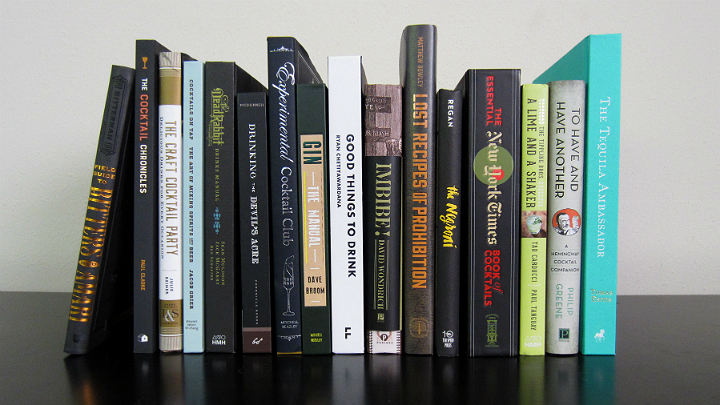
The global craft cocktail renaissance continues to grow by leaps and bounds. Bartenders and home enthusiasts alike are also experiencing a golden age of cocktail books. As the year draws to a close, we’ve gathered some of the best cocktail books of 2015. Cheers!
For a comprehensive list of (almost) all the cocktail and spirits books released in 2015, visit Alcademics.
BITTERMAN’S FIELD GUIDE TO BITTERS & AMARI
With perhaps the most industry-appropriate surname since Tito Beveridge, author Mark Bitterman has set the bar high with his October 2015 book, Bitterman’s Field Guide to Bitters & Amari. Bitterman packs a wealth of information into the handbook’s 216 pages, from introducing the history and science of bitters to 123 recipes for homemade bitters, bitters-forward cocktails and cooking with bitters. It might not be for everyone, but the Scorched Earth Bitters will certainly catch the reader’s eye with this description: “A dash or two of Scorched Earth ravages London gin, Tennessee whiskey, Jalisco tequila, and even Italian amaro with soil, smoke and fire, uprooting them from their civilized origins and leading your palate across forgotten terrain.” And the Ethiopian Chicken with Preserved Lemon Relish is an irresistible combination of Clare Barboza’s mouth-watering photography and Bitterman’s dreamlike synopsis: “Simple things unite, and your encampment is redolent with roasted spice and meat. Douse a bite with cardamom bitters. Now you stare up. The black night sky, buckshot with diamonds.”
The final two chapters are indispensable: “The Field Guide to Bitters” and “The Field Guide to Amari.” Rather than grading the 500 bitters and 50 amari from best to worst, the guides are intended to document what’s in the field. A panel of experts evaluated the bitters and amari by assigning scores (0 to 5) in three categories: bitterness, sweetness and aromatic intensity. Along with the scores, each product has tasting notes and a list of Inspired Uses. The comments are sometimes downright genius; tasting notes describe various bitters as “inexplicably waiting in a chair at the hair salon;” “redolent of a fish market after closing, then our boat was attacked by a massive salty cold squid;” and “Steve McQueen in a citrus race car.”
THE COCKTAIL CHRONICLES
“Life is complicated – a good drink doesn’t have to be. Please, enjoy… ” With that invitation, Paul Clarke takes readers on a journey through the current cocktail renaissance in his August 2015 book, The Cocktail Chronicles: Navigating the Cocktail Renaissance with Jigger, Shaker & Glass. Clarke, Executive Editor of Imbibe and the 2014 Tales of the Cocktail Spirited Award winner for Best Cocktail & Spirits Writer, notes that his book is neither a “lab manual for taking the cocktail experience to a molecular level” nor a “historical monograph tracing the details of our forebears.” The 200-plus cocktails, ranging from long-established classics to future icons and overlooked gems, were selected not only because they’re delicious and they contributed in some way to the ongoing renaissance, but also because they’re reasonably approachable and even the novice reader can replicate them at home.
Newbies and cocktail cognoscenti alike could not ask for a more knowledgeable, articulate and witty guide than Clarke, who launched his pioneering blog, The Cocktail Chronicles, in May 2005. Throughout the book, Clarke deftly bridges the gap between the cocktail geek and the casual drinker, particularly in the “Not Forgotten” collection of unearthed drinks. What could have slipped into an off-putting round-up of industry calling cards in less skilled hands, instead becomes an engaging and accessible chapter that anyone can appreciate and use. In his overview of gin, which includes the outstanding Alaska Cocktail (gin, Yellow Chartreuse, orange bitters), Clarke notes, “When the recipe says ‘gin,’ exactly what kind of gin does it mean? As with Modern art, pornography and Quentin Tarantino movies, the dividing line between ‘OMG!’ and ‘WTF?!’ will vary according to the user.”
The current generation of young bartenders will be inspired by “Staying Power,” featuring 40 “contemporary-ish” cocktails from the past decade that range from bonafide future classics to drinks that were unjustly overlooked and a few of Clarke’s personal favorites. Highlights include the Chartreuse Swizzle by Marcovaldo Dionysos; Bramble by Dick Bradsell; Penicillin by Sam Ross; Cosmopolitan by Toby Cecchini (“Yes, I put a goddamn Cosmo recipe in this book”) and the Réveillon Cocktail by L.A.’s Chuck Taggart, whose Gumbo Pages blog was an early inspiration and ongoing resource for Clarke.
COCKTAILS ON TAP
In March 2015, Portland-based bartender and writer, Jacob Grier published his first book, Cocktails On Tap: The Art of Mixing Spirits and Beer. Grier sets the stage by establishing seven styles of beer cocktails: Prepared Beers, Beer-Topped Cocktails, Beer-Incorporated Cocktails, Beer Flips, Cocktails with Beer Syrups, Beer Punches and Hot Beer Drinks. This last style will likely come as a surprise to most imbibers; Grier devotes an entire chapter to them in the hopes of re-introducing drinks like the Flip, Wassail, Mulled Ale and the Dog’s Nose to a modern audience. Drinks that combine beer and other ingredients go back centuries, and Grier starts his survey of vintage beer cocktails with a “Bang”: whiskey, nutmeg, ginger, ale and cider. Familiar drinks such as the Michelada and Boilermaker are included, along with more obscure recipes like the Shandygaff and the aptly named Blow My Skull. In the Contemporary Cocktails round-up, beer’s versatility as an ingredient is showcased by top bartenders such as L.A.’s own Karen Grill, who contributes the Beer and Loathing; the Detroiter by 320 Main’s Jason Schiffer; and the Lebowski Achiever by Brady Weise, who created his White Russian variation for the Winter 2011 menu at 1886 Bar.
THE CRAFT COCKTAIL PARTY
In May 2015, Julie Reiner, co-owner of Brooklyn’s Clover Club and the Flatiron Lounge in Manhattan published The Craft Cocktail Party: Delicious Drinks for Every Occasion. Named one of America’s “Top 10 Mixologists” by Food & Wine and nominated for a James Beard award, Reiner has been featured in publications like the New York Times and Bon Appétit and has also appeared on the Today Show and the Food Network.
Touted as a book “that provides inspiration for the rest of us, and not only the cocktail geeks,” The Craft Cocktail Party is not intended to be a comprehensive bartender manual. Instead, the focus is on making cocktails at home for special occasions, gatherings large and small, or even a party of one. In a home setting, the rules are more flexible and the reader is encouraged to “take certain liberties.” The book is organized into four seasonal sections. Chapters are devoted to a mix of holiday-inspired cocktails, classics and new creations, such as “From Tiki to Modern Tropical” in Summer, “Fireside Drinks” in Fall, “Sherry Sherry Christmas” in Winter and “Brunch” in Spring. Throughout the book, Reiner shares tricks, tips and techniques garnered from her 20-plus years of experience as a bartender and bar owner.
Newcomers to the craft cocktail world will appreciate the basic techniques that will have them shaking tins like a pro in no time, like juicing citrus. “It amazes me that people buy pre-made juice like the ones that come in the plastic lemon [ReaLemon]. It’s not ‘real’ unless you juice it from an actual lemon. With a hand juicer, it takes about five minutes to juice enough for five cocktails. Simple syrup is another one. It really is simple! Do not waste your money on a bottled simple syrup, just combine equal parts sugar and water and stir.”
Click here for our interview with Julie Reiner, who talks about The Craft Cocktail Party, entertaining at home and the importance of mentoring.
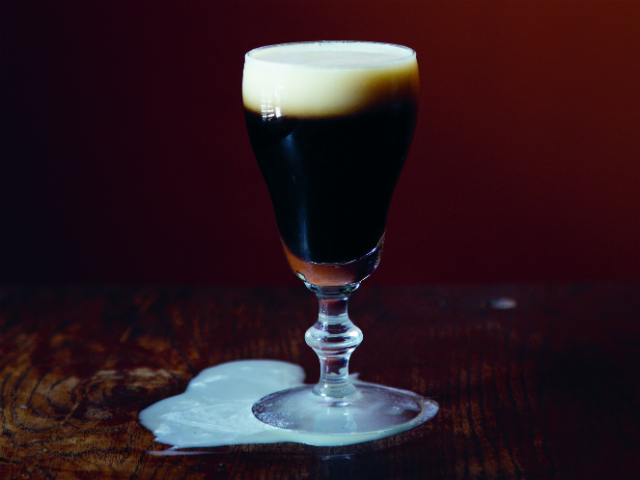
Irish Coffee from “Drinking the Devil’s Acre” | Photo by Luke Abiol
DRINKING THE DEVIL’S ACRE
The Devil’s Acre is described by author Duggan McDonnell as “a little island bordered by three streets, a triangular burg that was once the wickedest, wildest single block in the whole of the world and the backbone of the Barbary Coast.” Proprietor of acclaimed S.F. bar Cantina and co-founder of the award-winning Encanto Pisco, McDonnell published Drinking the Devil’s Acre: A Love Letter from San Francisco and Her Cocktails in September 2015. The book’s unique approach weaves together history, memoir, cocktail recipes and hard-earned bartender wisdom. Because of its narrative structure, Drinking the Devil’s Acre is meant to be read front-to-back, unlike other books in this year-end list that can be absorbed from various points.
The book is centered on 25 “vignettes” – each focused on a single drink’s story and importance to S.F. – then discusses the cocktail’s ingredients, e.g. the origins of gin for the Martinez, along with recipes for a few related cocktails and descendants. Along the way, readers will learn about drinks long associated with San Francisco, like the Pisco Punch and Irish Coffee, as well as S.F.’s contributions to the Sazerac and Pisco Sour, and the ancestry of the world’s first cocktail. “The Bartender’s Secret Formula” is a series of recipes for blending spirits to create Superior Cocktail Old Tom Gin, Superior Cocktail Whiskey, Superior Cocktail Blackstrap Rum and more.
Drinking the Devil’s Acre really hits his stride with McDonnell’s historic asides. The book’s introduction is a cinematic walk through San Francisco that starts with McDonnell opening Cantina for service, continues with an East India cocktail at the Burritt Room, a Chinese Mai Tai at Li Po, past the triangle known as the Devil’s Acre, down Pacific Avenue (aka Terrific Street), and ends in front of the Transamerica Pyramid and the site of the Montgomery Block, home of the legendary Bank Exchange Saloon.
McDonnell dedicates the book “to everyone everywhere who has ever enjoyed a cocktail in San Francisco.” And whether you’re a lifelong resident, frequent visitor or have yet to visit, you’ll find no better tour guide than Duggan McDonnell.
THE DEAD RABBIT DRINKS MANUAL
At the 9th Annual Tales of the Cocktail Spirited Awards, The Dead Rabbit Grocery and Grog was named World’s Best Bar, adding to the New York bar’s collection of Tales accolades, which include Best American Cocktail Bar and World’s Best Drink Selection in 2014, and World’s Best New Cocktail Bar, World’s Best Cocktail Menu and International Bartender of the Year (for bar manager Jack McGarry) in 2013. Incredibly, McGarry and The Dead Rabbit’s managing partner, Sean Muldoon had won the Spirited Award for World’s Best Cocktail Bar in 2010 with their previous collaboration, The Bar at The Merchant Hotel in Belfast, Ireland.
In October 2015, McGarry, Muldoon and writer Ben Schaffer published the highly-anticipated The Dead Rabbit Drinks Manual: Secret Recipes and Barroom Tales from Two Belfast Boys Who Conquered the Cocktail World. Located in a 19th century brownstone in Lower Manhattan, The Dead Rabbit takes its name from the infamous Irish street gang, the Dead Rabbits. The ground floor of the three-level space is occupied by the Taproom, an informal setting “in the style of the waterfront dock bars that would have been the respite of working men and women.” The Taproom features a raw bar, pub fare, bottled punch and whiskeys of the world. On the second floor, the Parlor offers “rarefied quarters for cocktail consumption,” with small plates, communal punch and 72 historically accurate cocktails from the 19th century’s most celebrated bartenders. The third-floor Occasional Room is devoted to private events.
Every drink in The Dead Rabbit Drinks Manual is an original recipe, listed with its historical source material. As noted in the intro, the recipes are “all-new renditions, not only updated for modern ingredients and the modern palate, but enhanced, deepened, awoken through the inspiration of our authors.” Spanning the entirety of The Dead Rabbit experience, recipes are grouped into categories such as Communal Punch, Punches for the Bar Use (“individually sized punch in disguise as a regular mixed drink”), Fixes and Daisies, Slings and Toddies, Bishops (spiced wine drinks), Absinthe, and Diverse and Invalid Drinks (“preparations for the ill, rather than beverages that are baseless or unsound.”).
Whether it’s to vicariously make a pilgrimage to this cocktail mecca, expand your drink-making repertoire or to inspire further research into history, The Dead Rabbit Drinks Manual is an essential addition to any cocktail book library.
THE ESSENTIAL NEW YORK TIMES BOOK OF COCKTAILS
Clocking in at 480 pages, The Essential New York Times Book of Cocktails gathers more than 350 drink recipes and essays by an all-star roster of writers, including Mark Bittman, Craig Claiborne, Toby Cecchini, Eric Asimov, Rosie Schaap, Robert Simonson, Melissa Clark, William L. Hamilton, Jonathan Miles, Amanda Hesser, William Grimes and many more. Edited by Steve Reddicliffe, who writes “A Quiet Drink” for The Times, the compendium devotes entire chapters to classic cocktails like the Old-Fashioned, Manhattan, Martini, Negroni, Daiquiri and Margarita. Other chapters focus on The Shrub, Bitters and Amari, Summer Drinks, Frozen Drinks, New School and Global Affairs.
While most of the book is culled from the cocktail renaissance of the last decade and a half, there are delightful chapters that go back much further, like “Cocktails by Claiborne” (anyone want to share the Appendicitis de Luxe?) and “Cocktails from the Archive,” which includes a July 1910 article titled “Fine Art in Making Cool Summer Drinks,” which features cocktails like the Clover Club and the Astor Punch, made with Sloe Gin, Creme de Menthe, shaved ice and sliced pineapple. An op-ed piece, published a year later in July 1911, offers these choice words about the Mint Julep: “But whoever said that a mint julep should contain water is fit only for chocolate sundaes and such things. A mint julep may be pernicious, but it should not be misrepresented.”
Some of the essays go beyond just good times. In his 2002 column, “Summer in a Tall Glass,” acclaimed bartender Toby Cecchini wrote, “I’ve lent my personal spin to every drink I come across, but I’ve never been able to better my father’s rendition of the gin and tonic.” Rosie Schaap writes about cocktail as memory in her heartfelt column from October 2012, “Make Mine Manhattan.” She first drank Manhattans with her late husband Frank, and now she drinks them in his honor since he passed away in 2010.
The Essential New York Times Book of Cocktails will be a constant companion for years to come, whether it’s used as a handy reference for recipes or a reliable go-to for nightstand reading.
EXPERIMENTAL COCKTAIL CLUB
“Every night, in each of our bars, we strive to deliver the best drinks we can possibly make, using the freshest ingredients, with service, music and atmosphere to match the quality of the cocktails in the glasses.” While this could be a manifesto for the global bar community, it’s an excerpt from Experimental Cocktail Club by Olivier Bon, Pierre-Charles Cros, Romée de Goriainoff and Xavier Padavoni.
Friends since childhood, de Goriainoff, Cros and Bon took the inspiration they found from years of travelling to the Big Apple to create a New-York-style bar in the heart of Paris. In 2007 they opened their first bar, Experimental Cocktail Club and kicked off a cocktail revolution in the City of Lights. Padovani joined the team as the fourth partner in 2010. The group now operates four cocktail bars in Paris, and bars in London, New York and Ibiza.
Published in November 2015, Experimental Cocktail Club gathers 85 recipes from the collective’s history, from their first bar on Rue Saint-Sauveur to Experimental Beach Ibiza, their version of ECC “gone on holiday.” Each set of recipes is introduced with the bar’s backstory and an evocative description – ECC Chinatown in London is “nestled above a Chinese restaurant, with Art Deco touches, vintage Chinese wallpaper, handmade carpets and a hidden piano, a jolly and eclectic mix which fits together like a puzzle.”
Inspired by American and French classic cocktails, ECC bartenders bring an international flair to creations like Le Maudit Français (armagnac, oloroso sherry, orange juice, lemon juice, maple syrup, Bittermens Boston Bittahs), Sainte Thérèse (Santa Teresa 1796 rum, Velvet Falernum, lime juice, Lillet Rouge), and To All My Friends, a boozier Grasshopper made with Pierre Ferrand Ambre Cognac, Carpano Antica, lemon juice, sugar syrup and Fernet-Branca. The Classics section offers a great twist on the usual collection of favorites – ECC variations are featured alongside their inspirations, such as the Harvard (a cognac Manhattan) and ECC’s Requiem for a Drink (cognac, Cynar, marsala, Mozart Dark Chocolate Liqueur, St. Elizabeth Allspice Dram); or the classic Paloma and the Game of Thrones inspired Winter is Coming, made with aquavit, Amaro Montenegro, lemon, grapefruit, topped with soda water.
Ready for another round? Here’s Part Two of our guide to the Best Cocktail Books of 2015!

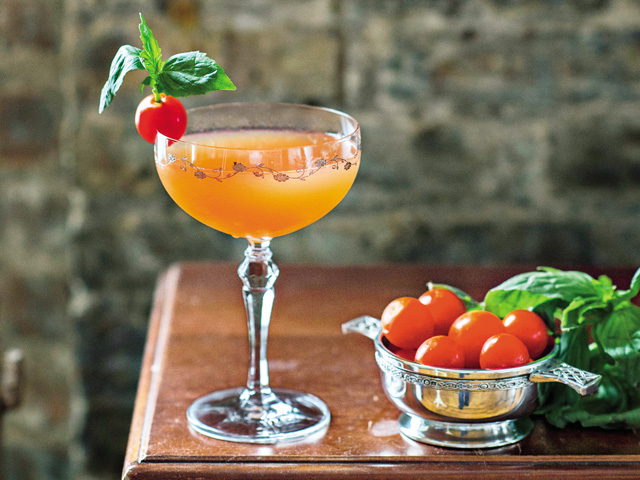
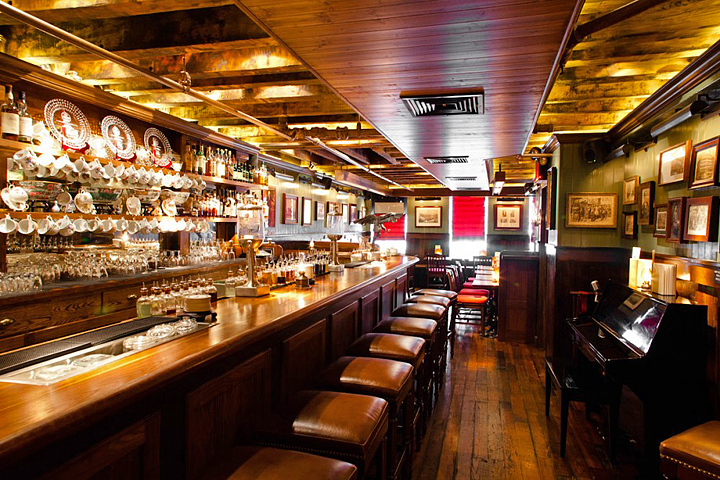
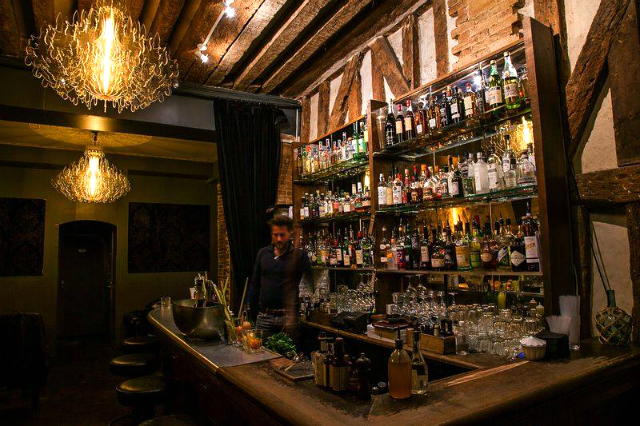
[…] As 2015 comes to a close, we look back on yet another banner year for cocktail books. Read on for Part Two of our guide to the best cocktail books of 2015. Thirsty for more? Then check out Part One! […]